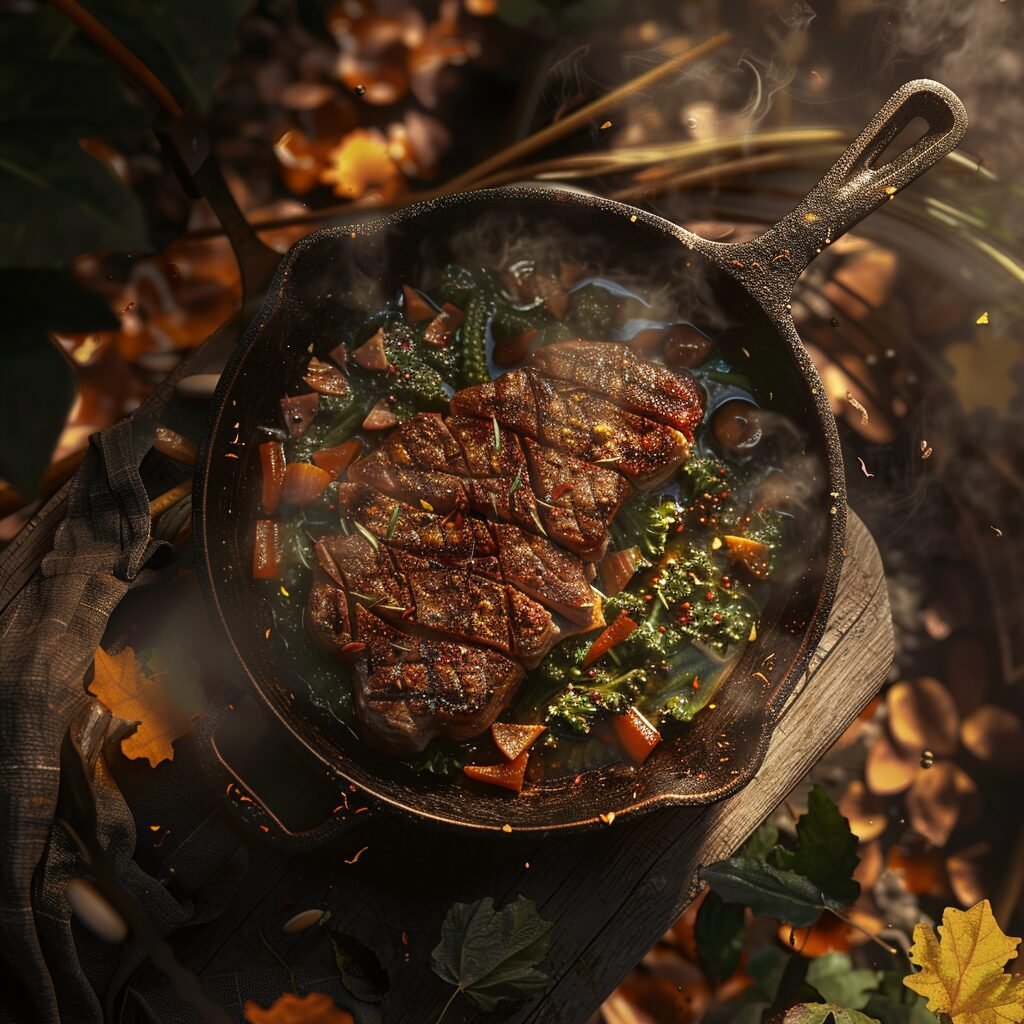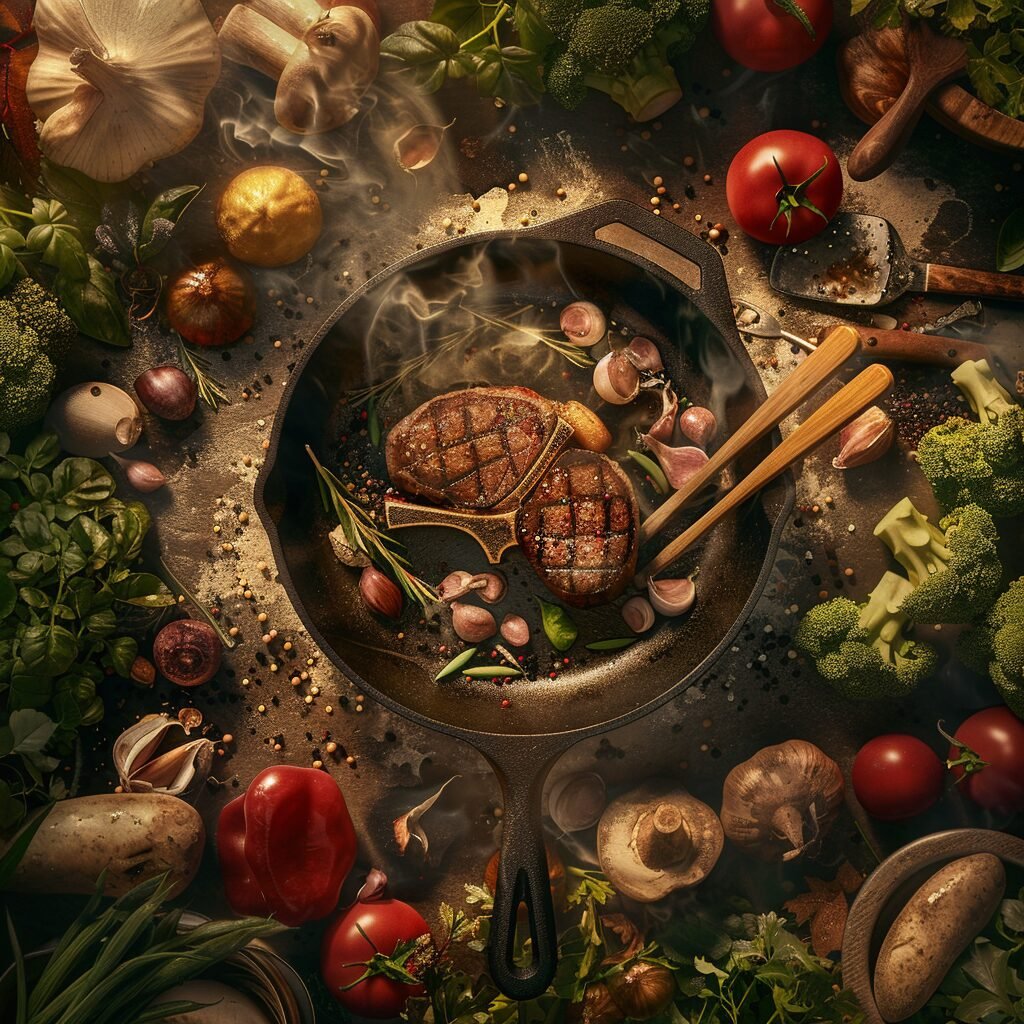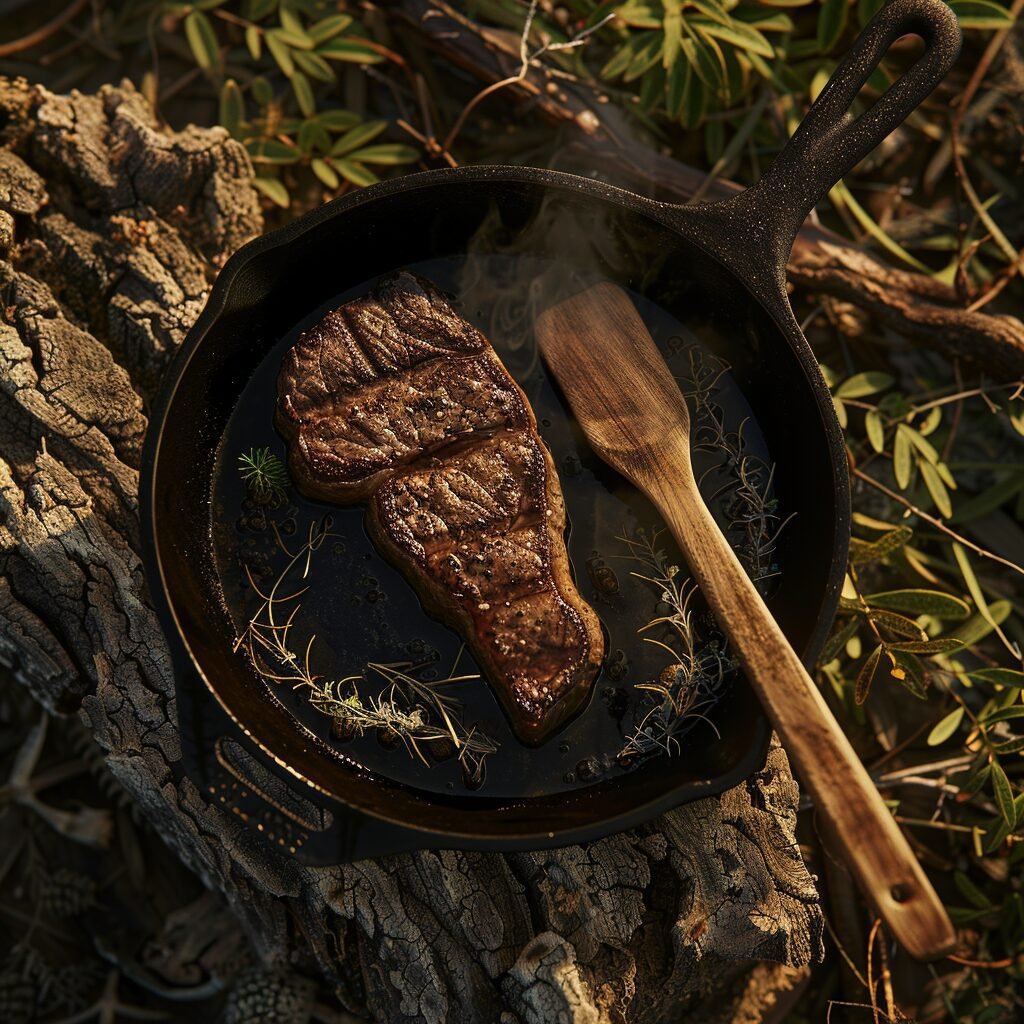For those prepping to survive in an urban center, the ability to cook delicious and satisfying meals is crucial. One technique that should be in every prepper’s repertoire is searing steak in cast iron. This method not only delivers unbeatable flavor but also allows you to make the most of limited resources, as a properly seared steak can be a filling and nutritious meal.
In this comprehensive guide, you’ll learn the ultimate tips and techniques for how to sear a steak cast iron to perfection, achieving a delectable crust and juicy interior every time.
Key Takeaways
- Understand why cast iron is the ideal cookware for searing steaks
- Master essential prep steps for steaks before searing
- Learn foolproof searing techniques for a perfect crust
- Discover tips for finishing and resting seared steaks
- Explore recipe variations and proper cast iron care
Table of Contents
Why Sear Steak in Cast Iron?




Searing steak in a cast iron skillet is the ultimate way to achieve a delicious, crusty exterior and a juicy, flavorful interior.
The intense heat retained by cast iron creates a perfectly seared steak with a deep, caramelized crust that locks in the steak’s natural flavors. This searing technique for cast iron steak is superior to other cooking methods because:
- Cast iron heats evenly and retains heat incredibly well, allowing for consistent and intense searing.
- The naturally non-stick surface of seasoned cast iron promotes easy release and excellent browning.
- Cast iron can go from stovetop to oven, making it versatile for different searing and finishing techniques.
| Cast Iron Benefits | Description |
|---|---|
| Even Heat Distribution | Promotes consistent searing and browning |
| Heat Retention | Allows for intense searing and crust development |
| Naturally Non-Stick | Seasoned surface prevents sticking and promotes browning |
| Versatility | Can go from stovetop to oven for different cooking techniques |
Essential Equipment for Searing Steak
To achieve the best seared steak cast iron results, you’ll need the right equipment. Here’s what you’ll need:
The Right Cast Iron Skillet
- A heavy, thick cast iron skillet with a smooth cooking surface is ideal for searing steaks.
- Look for a skillet with a diameter slightly larger than your steaks to allow for easy flipping and basting.
- Enameled or pre-seasoned cast iron skillets work well, but you’ll need to season them regularly.
Other Necessary Tools
- Tongs for flipping and handling the steak
- A pastry brush for basting (optional)
- A meat thermometer for monitoring internal temperature
- Oven mitts or pot holders for handling the hot cast iron skillet
Prep Your Steak for Perfect Searing

Proper steak preparation is crucial for achieving a perfect sear. Follow these steps:
- Choosing the Right Cut: Opt for thick, well-marbled steaks like ribeye, strip, or filet mignon. Thinner cuts may overcook before developing a nice crust.
- Patting Steak Dry: Use paper towels to thoroughly pat the steak dry. Surface moisture will cause steaming instead of searing.
- Let it Reach Room Temperature: Allow the steak to sit at room temperature for 30-60 minutes before cooking. This ensures even cooking from edge to edge.
- Season Generously: Just before searing, season the steak liberally with salt and pepper (or your preferred seasoning blend) on all sides.
Mastering the Searing Technique
Now that you have the right equipment and your steak is prepped, it’s time to master the searing techniques for cast iron steak. Follow these steps for a perfect sear:
- Get Your Cast Iron Ripping Hot: Preheat your cast iron skillet over high heat for at least 5 minutes before adding oil. The skillet should be smoking hot.
- Add Oil and Preheat: Add a high smoke point oil, like avocado or grapeseed oil, and let it get hot and shimmering.
- Sear Steak Properly:
- Carefully add the steak to the hot skillet, making sure not to overcrowd the pan.
- Let it sear undisturbed for 2-3 minutes to develop a nice crust.
- Don’t Move Steak Too Much: Resist the urge to move the steak around, as this can prevent proper browning.
- Basting and Flipping:
- Use tongs to flip the steak, and baste with the hot oil to ensure even browning on all sides.
- For thicker steaks, you may need to sear the edges by holding the steak upright with tongs.
| Searing Technique | Description |
|---|---|
| Preheat Cast Iron | Get the skillet ripping hot before adding oil |
| Use High Smoke Point Oil | Avocado, grapeseed, or other high smoke point oil |
| Don’t Move Steak Too Much | Let it sear undisturbed for 2-3 minutes per side |
| Baste and Flip | Use tongs to flip and baste with hot oil |
| Sear Edges (Thick Steaks) | Hold steak upright with tongs to sear edges |
Tips for Perfectly Seared Crust

To achieve the ultimate seared crust on cast iron steak, follow these tips:
- Use Enough Oil/Butter: Don’t be afraid to use a generous amount of oil or butter to promote browning and prevent sticking.
- Don’t Move Steak Too Much: Resist the urge to move the steak around, as this can prevent proper browning and crust formation.
- Sear Edges Too: For thicker steaks, be sure to sear the edges by holding the steak upright with tongs.
- The Moisture Trick:
- If the steak seems to be drying out or not browning properly, try this trick:
- Flick a few droplets of water into the hot skillet. The moisture will quickly evaporate, creating steam that promotes browning.
Finishing and Resting the Steak

Once you’ve achieved a beautiful sear on your cast iron skillet steak, it’s time to finish cooking and let it rest:
Oven Finishing Technique
- For thicker steaks, you may want to finish cooking in the oven after searing.
- Preheat your oven to the desired doneness temperature (e.g., 125°F for rare, 135°F for medium-rare).
- Transfer the seared steak to a wire rack set over a baking sheet and place in the preheated oven.
- Use a meat thermometer to monitor the internal temperature and remove the steak when it’s 5-10°F below your desired doneness.
Resting Importance and Times
- Resting is crucial for juicy, tender steaks. It allows the juices to redistribute throughout the meat.
- For thinner steaks (under 1 inch thick), rest for 5 minutes.
- For thicker steaks (1-2 inches thick), rest for 10-15 minutes.
- The Carry-Over Cooking Effect:
- The steak’s internal temperature will continue to rise by 5-10°F after removing it from the heat source.
- Factor this into your desired doneness temperature when removing the steak from the oven or pan.
Searing Steak at Home vs Restaurant
While restaurants have the advantage of high-powered commercial equipment, it is possible to achieve restaurant-quality seared steak at home with the right techniques and equipment. However, there are a few challenges to be aware of:
- Home stoves and ovens may not reach the same intense heat levels as commercial equipment, making it harder to achieve a deep, even sear.
- Cast iron skillets can only get so hot before reaching their maximum temperature, limiting the potential for searing.
- Proper ventilation is crucial when searing at home, as it can create a lot of smoke.
To replicate restaurant results at home, use the thickest, heaviest cast iron skillet you can find, preheat it well, and consider finishing the steak in a very hot oven after searing.
Cast Iron Steak Recipe Variations
Once you’ve mastered the basics of searing steak on cast iron skillet, you can experiment with different recipes and flavor variations:
Classic Cast Iron Ribeye
- Season a thick, well-marbled ribeye steak with salt, pepper, and garlic powder.
- Sear in a hot cast iron skillet until a deep crust forms.
- Finish in the oven if needed, then rest and serve with a compound butter or red wine reduction.
Garlic Butter Seared Filet
- Pat filet mignon steaks dry and season with salt and pepper.
- Sear in a cast iron skillet with a mixture of butter and olive oil.
- Once seared, baste the steaks with the hot garlic butter mixture, flipping and basting until cooked to desired doneness.
- Rest and serve with extra garlic butter sauce spooned over the top.
Reverse Seared Cast Iron Steak
- Season steak as desired and slowly cook in the oven until it reaches 10-15°F below your desired doneness temperature.
- Remove from oven and let rest briefly.
- Get your cast iron ripping hot and sear the steak for 1-2 minutes per side to develop a crusty exterior.
- Let rest again before slicing and serving.
Cleaning and Caring for Your Cast Iron
Proper cleaning and care of your cast iron skillet is essential for maintaining its non-stick properties and prolonging its lifespan. Follow these tips:
- Cleaning: After use, scrub the hot skillet with a stiff brush and coarse salt to remove any stuck-on bits. Rinse with hot water and dry thoroughly.
- Seasoning: Once dry, rub a thin coat of vegetable oil or shortening over the entire surface, including the sides and bottom. Place the skillet upside down in a hot oven (300-400°F) for 1 hour to “season” it.
- Storage: Store your seasoned cast iron skillet in a dry place, and consider placing a paper towel or cloth inside to absorb moisture.
- Avoid Soap: Soap can strip away the seasoning, so avoid using it unless absolutely necessary. If you must use soap, be sure to re-season the skillet afterwards.
With the right techniques and care, your cast iron skillet will become a cherished tool for searing steaks and countless other dishes for years to come.
Conclusion

Mastering how to sear a steak cast iron is a game-changer for any home cook or urban prepper. With the right techniques and a high-quality cast iron skillet, you can achieve restaurant-quality steaks right in your own kitchen or survival dwelling.
From the intense searing process that creates an irresistible crust to the precise resting periods that lock in juiciness, this guide has provided you with all the knowledge needed to elevate your steak game.
Remember, practice makes perfect, so don’t be discouraged if your first few attempts aren’t flawless. Keep experimenting, trying new seasoning blends and recipes, and soon enough, you’ll be the master of the cast iron seared steak.
| Key Point | Description |
|---|---|
| Cast Iron Superiority | Cast iron’s excellent heat retention and naturally non-stick surface make it ideal for searing steaks. |
| Proper Prep | Patting steaks dry, bringing them to room temp, and generous seasoning are crucial prep steps. |
| Hot Searing Technique | Get the skillet ripping hot, use a high smoke point oil, and sear undisturbed for the perfect crust. |
| Finishing and Resting | Oven finishing and proper resting times ensure a juicy, evenly cooked steak. |
| Recipe Variations | From classic ribeyes to garlic butter filets, explore flavor-packed cast iron steak recipes. |
| Cast Iron Care | Proper cleaning and seasoning maintain your skillet’s non-stick properties for years of use. |
With this comprehensive guide under your belt, you’re now equipped to sear up amazingly delicious steaks, even in the most challenging urban survival scenarios. So fire up that cast iron, and get searing!


